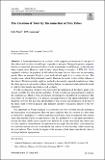The creation of twist by reconnection of flux tubes
Abstract
A fundamental process in a plasma is the magnetic reconnection of one pair of flux tubes (such as solar coronal loops) to produce a new pair. During this process magnetic helicity is conserved, but mutual helicity can be transformed to self-helicity, so that the new tubes acquire twist. However, until recently, when Wright (Astrophys. J. 878 , 102, 2019) supplied a solution, the partition of self-helicity between the two tubes was an outstanding puzzle. Here we examine Wright’s result in detail and apply it to a variety of cases. The simplest case, which Wright himself used to illustrate the result, is that of thin ribbons or flux sheets. We first explicitly apply his method to the usually expected standard case (when the tubes approach one another without twisting before reconnection) and confirm his result is valid for flux sheaths and tubes as well as sheets. For the reconnection of sheets, it is shown that the orientation of the sheets needs to be chosen carefully. For flux sheaths and tubes, Wright’s results are demonstrated to hold for the standard case. There is both a local and a global aspect to the effect of reconnection. The local effect of reconnection is to produce an equipartition of the added self-helicity (and therefore of twist), but the extra global effect of the location and orientation of the feet of the sheet, shell or tube in general adds different amounts of magnetic helicity to the two structures. It is important, as Wright realized, to account for any twist or writhe already existing in the fluxes prior to reconnection. Here we show explicitly that, if a section of a flux sheet is twisted by a multiple of π with its ends held fixed and is then reconnected with another sheet, then the effect of the reconnection is to add that multiple of π to one sheet and subtract it from the other, while conserving the total helicity. If, on the other hand, the central part of a flux sheath is twisted before reconnection by any angle, then the effect of reconnection is to add that amount of twist to one sheath and subtract it from the other, while conserving the total helicity. Thus, for the local part of the process in both sheets and sheaths, there is no longer helicity equipartition. Finally, we apply Wright’s results explicitly to flux tubes, and in particular to determine the twist that is acquired by an erupting flux rope due to reconnection during an eruptive solar flare or coronal mass ejection.
Citation
Priest , E R & Longcope , D W 2020 , ' The creation of twist by reconnection of flux tubes ' , Solar Physics , vol. 295 , 48 . https://doi.org/10.1007/s11207-020-01608-0
Publication
Solar Physics
Status
Peer reviewed
ISSN
0038-0938Type
Journal article
Collections
Items in the St Andrews Research Repository are protected by copyright, with all rights reserved, unless otherwise indicated.

